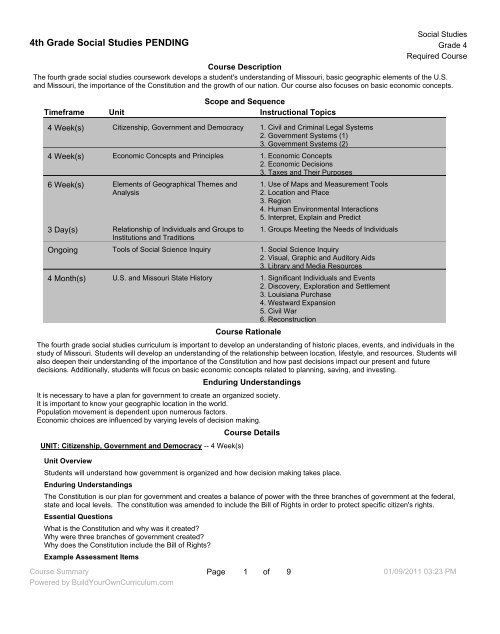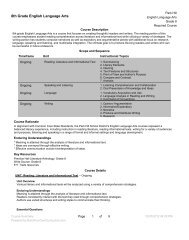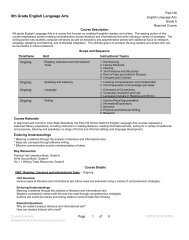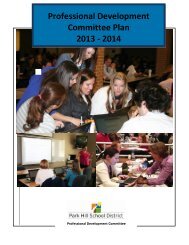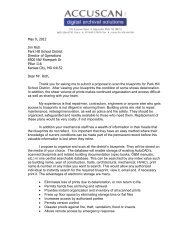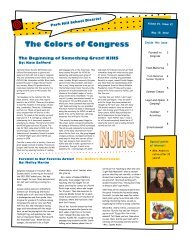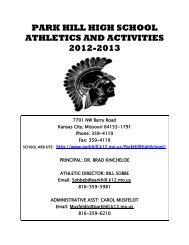4th Grade Social Studies PENDING
4th Grade Social Studies PENDING
4th Grade Social Studies PENDING
Create successful ePaper yourself
Turn your PDF publications into a flip-book with our unique Google optimized e-Paper software.
<strong>Social</strong> <strong>Studies</strong><strong>4th</strong> <strong>Grade</strong> <strong>Social</strong> <strong>Studies</strong> <strong>PENDING</strong><strong>Grade</strong> 4Required CourseCourse DescriptionThe fourth grade social studies coursework develops a student's understanding of Missouri, basic geographic elements of the U.S.and Missouri, the importance of the Constitution and the growth of our nation. Our course also focuses on basic economic concepts.Scope and SequenceTimeframe Unit Instructional Topics4 Week(s) Citizenship, Government and Democracy 1. Civil and Criminal Legal Systems2. Government Systems (1)3. Government Systems (2)4 Week(s) Economic Concepts and Principles1. Economic Concepts2. Economic Decisions3. Taxes and Their Purposes6 Week(s) Elements of Geographical Themes andAnalysis1. Use of Maps and Measurement Tools2. Location and Place3. Region4. Human Environmental Interactions5. Interpret, Explain and Predict3 Day(s) Relationship of Individuals and Groups to 1. Groups Meeting the Needs of IndividualsInstitutions and TraditionsOngoingTools of <strong>Social</strong> Science InquiryCourse RationaleThe fourth grade social studies curriculum is important to develop an understanding of historic places, events, and individuals in thestudy of Missouri. Students will develop an understanding of the relationship between location, lifestyle, and resources. Students willalso deepen their understanding of the importance of the Constitution and how past decisions impact our present and futuredecisions. Additionally, students will focus on basic economic concepts related to planning, saving, and investing.Enduring UnderstandingsIt is necessary to have a plan for government to create an organized society.It is important to know your geographic location in the world.Population movement is dependent upon numerous factors.Economic choices are influenced by varying levels of decision making.1. <strong>Social</strong> Science Inquiry2. Visual, Graphic and Auditory Aids3. Library and Media Resources4 Month(s) U.S. and Missouri State History1. Significant Individuals and Events2. Discovery, Exploration and Settlement3. Louisiana Purchase4. Westward Expansion5. Civil War6. ReconstructionUNIT: Citizenship, Government and Democracy -- 4 Week(s)Unit OverviewCourse DetailsStudents will understand how government is organized and how decision making takes place.Enduring UnderstandingsThe Constitution is our plan for government and creates a balance of power with the three branches of government at the federal,state and local levels. The constitution was amended to include the Bill of Rights in order to protect specific citizen's rights.Essential QuestionsWhat is the Constitution and why was it created?Why were three branches of government created?Why does the Constitution include the Bill of Rights?Example Assessment ItemsCourse Summary Page 1 of 9Powered by BuildYourOwnCurriculum.com01/09/2011 03:23 PM
<strong>4th</strong> <strong>Grade</strong> <strong>Social</strong> <strong>Studies</strong> <strong>PENDING</strong><strong>Social</strong> <strong>Studies</strong><strong>Grade</strong> 4Required Course Given a picture of the "founding fathers" the students will explain why the constitution was written. Given a graphic organizer, students will identify the 3 branches of government and describe their duties andresponsibilities and display knowledge using digitial media. (i.e. create a table in word, create a graphic organizer onGliffy) Given a picture of an uneven balance with a branch of government on each side, students will be able to describeone way the Constitution ensures a balance government. Given a specific right from the Bill of Rights students will be able to describe that right through the use of words andpictures. (create a poster)Academic Vocabularystate governmentconsequencesauthoritativeconflict resolutiongovernmentBill of RightsConstitutionstate governmentlaws enforcedTOPIC: Civil and Criminal Legal Systems [Ongoing]Learning TargetsThe student will describe how authoritative decisions are made, enforced and interpreted within the state government.Assessment:·The students will evaluate constructive processes or methods for resolving conflicts by using a problem-solving organizer.TOPIC: Government Systems (1) [Ongoing]Learning TargetsThe student will explain the major purpose of the Constitution.The student will describe rights included in the Bill of Rights, including freedoms of religion, speech, press; to assemblepeacefully; to petition the government; and to be treated fairly by the government.The student will explain the purpose of the Bill of Rights.TOPIC: Government Systems (2) [Ongoing]Learning TargetsThe student will explain why Missouri has a constitution and why the state makes and enforces laws.Assessment:·The student will compare the functions of the three branches of government in the state government.UNIT: Economic Concepts and Principles -- 4 Week(s)Unit OverviewStudents will learn basic economic concepts such as saving vs. investing, supply and demand, and factors that affect decisionmaking.Enduring UnderstandingsCourse Summary Page 2 of 9Powered by BuildYourOwnCurriculum.com01/09/2011 03:23 PM
<strong>4th</strong> <strong>Grade</strong> <strong>Social</strong> <strong>Studies</strong> <strong>PENDING</strong>Economic decisions are made based on an individual's economic situation and priorities.There are many advantages and disadvantages to both saving and investing.Decisions of businesses and individuals are often based on supply and demand.Taxes are used to provide goods and services to citizens of a state.Essential QuestionsHow do people decide what to do with their money?Why do people save and invest?How do businesses decide how much something should cost?Why do people pay taxes?Example Assessment Items<strong>Social</strong> <strong>Studies</strong><strong>Grade</strong> 4Required Course Given a scenario, students will decide if someone should save or invest their money? (i.e. Tammy got an extra $100in her paycheck this month. Should she save it or invest it? Explain why you feel this way.) Given a scenario, students decide if the cost of an item will go up or down according to the supply and demand of theitem. (ie. A new type of silly bandz was just created. Each store in the area only got 5 packages. What might happen tothe cost of this item?) Given a list of 4 ways we spend tax dollars, students will decide where the money should be spent and give reasonsfor their selections. Given the question - Why do we pay taxes? - students will create a T-chart explaining the goods and services thatare provided from the taxes that people pay. Given the scenario of road improvements students will explain how decisions are made that affect the householdsand businesses of that area.Academic Vocabularyeconomicsupplydemandsavingfinancial investmentinterdependentgoodsservicestaxesTOPIC: Economic Concepts [Ongoing]Learning TargetsThe student will explain supply and demand.Assessment:TOPIC: Economic Decisions [Ongoing]Learning TargetsThe student will compare saving and financial investment.Assessment:The student will interpret past, explain present and predict future consequences of economic decisions.The student will explain how decisions of households, businesses and governments affect one another.Course Summary Page 3 of 9Powered by BuildYourOwnCurriculum.com01/09/2011 03:23 PM
<strong>4th</strong> <strong>Grade</strong> <strong>Social</strong> <strong>Studies</strong> <strong>PENDING</strong>TOPIC: Taxes and Their Purposes [Ongoing]Learning Targets<strong>Social</strong> <strong>Studies</strong><strong>Grade</strong> 4Required CourseThe student will explain how the state gets the money it needs to provide goods and services, especially by the collectionof sales tax.Assessment:UNIT: Elements of Geographical Themes and Analysis -- 6 Week(s)Unit OverviewStudents will use maps to determine their location in relation to the rest of the world and study the geography of a region and howit affects the people who live there (past, present, and future).Enduring UnderstandingsPeople use maps to determine their location.A person is affected by the region they live in.Geography helps us understand the past, present, and future.Geography helps us learn about our state and how is was developed.Essential QuestionsHow do people read and use maps?How does where you live affect what you do?How are rivers used in our lives? (past, present, future)How does geography help us to understand the state that we live in?Example Assessment Items Given a map, students will use a legend to identify locations on the map. Given a map, students will create a legend and identify specific locations on the map. Given a picture of a region (such as mountainous), students will identify jobs people might have and recreationalactivities in that area. Given a region, students will identify jobs and recreational activities in the region and display their knowledge usingdigital media. (ie. create a PowerPoint about a specific region; create a graphic organizer to compare and contrast 2regions such as mountainous area and plains). Students will be able to generate 2 or more ways rivers have been used in the past, present, or future. Given a map of Missouri, students will identify the major cities and rivers of Missouri and identify where they live(Kansas City).Academic VocabularygeographyagricultureenvironmentregionconsequencesTOPIC: Use of Maps and Measurement Tools [Ongoing]Learning TargetsThe student will construct and interpret maps of Missouri, including the cities of Kansas City, Springfield, St. Louis,Jefferson City, Columbia and St. Joseph.Assessment:Course Summary Page 4 of 9Powered by BuildYourOwnCurriculum.com01/09/2011 03:23 PM
<strong>4th</strong> <strong>Grade</strong> <strong>Social</strong> <strong>Studies</strong> <strong>PENDING</strong>TOPIC: Location and Place [Ongoing]Learning Targets<strong>Social</strong> <strong>Studies</strong><strong>Grade</strong> 4Required CourseThe student will describe human characteristics (e.g., population composition, architecture, kinds of economic andrecreational activities, transportation and communication networks) of a place (e.g., the regions or important cities ofMissouri).Assessment:TOPIC: Region [Ongoing]Learning TargetsThe student will compare regions (e.g., explain how life in a city region is different from life in a rural region or howlandscapes in mountainous regions look different from landscapes in plains regions).Assessment:TOPIC: Human Environmental Interactions [Ongoing]Learning TargetsThe student will describe how people are affected by, depend on, adapt to and change their environments.Assessment:TOPIC: Interpret, Explain and Predict [Ongoing]Learning TargetsThe student will use geography to interpret the past (e.g., why rivers have played an important role in humantransportation).Assessment:UNIT: Relationship of Individuals and Groups to Institutions and Traditions -- 3 Day(s)Unit OverviewStudents will analyze how needs are met by groups and organizations. (i.e. governments, businesses, schools, religiousinstitutions and charitable organizations)Enduring UnderstandingsPeople's needs are met in many different ways.Essential QuestionsHow does the government help people get what they need?How can other groups help people get what they need?Example Assessment Items Given a problem a citizen might have, students will identify one way the government might help someone solve thisproblem. (i.e. Someone was let go from their job. How might the government help them get money to take care of theirfamily?) Given a problem a citizen might have, students will identify an organization other than the government who mighthelp the citizen solve this problem. (i.e. A family is running low on money and does not have enough to buy groceries.Describe other organizations who might be able to help this family.)Course Summary Page 5 of 9Powered by BuildYourOwnCurriculum.com01/09/2011 03:23 PM
<strong>4th</strong> <strong>Grade</strong> <strong>Social</strong> <strong>Studies</strong> <strong>PENDING</strong>Academic Vocabularyneedswants<strong>Social</strong> <strong>Studies</strong><strong>Grade</strong> 4Required CourseTOPIC: Groups Meeting the Needs of Individuals [Ongoing]Learning TargetsThe student will analyze how needs are met by groups and organizations (e.g., governments, businesses, schools,religious institutions, charitable organizations).Assessment:UNIT: Tools of <strong>Social</strong> Science Inquiry -- OngoingUnit OverviewStudents will use various resouces to conduct research.Enduring UnderstandingsArtifacts are useful in determining what life was like in the past.Visual representations enhance student understanding of a topic.Some resources are more reliable than others.Essential QuestionsHow could you decide on and create an artifact to represent a person or group of people?How could you use technology for a class presentation?What are some resources you could use for a research project?How do you decide which resource has the best (most reliable) information?Example Assessment Items Given a famous Missourian, students will create an artifact to represent this person. (i.e. a book cover for TomSawyer might represent Mark Twin) Given a group of people related to Missouri, students will create an artifact to represent this group of people. (i.e.create or find artifacts to put in a wagon to represent what someone heading west might have taken with them) Given a specific scenario such as traveling to the West along the Oregon trail; students will create a diary entrydocumenting what life was like along their travels. Given a topic, students will display their knowledge using digital media. (i.e. create a PowerPoint or use Gliffy tocreate a graphic organizer)Given a topic, students will use 2 or more resources to gather research including at least 1 technology resource (i.e. usean encyclopedia, nonfiction books, Awesome Library, NASA Kids, Fact Monster, Kids Click, Ask for Kids) Given 2 resources, students will identify the most reliable resource with the best information. (i.e. Give students anencyclopedia entry and a wikipedia entry on the same topic. Have students decide which is the most reliable information.)Academic Vocabularyinquiryvisualgraphicauditory aidsdiagramcivicsprimary sourcesecondary sourceCourse Summary Page 6 of 9Powered by BuildYourOwnCurriculum.com01/09/2011 03:23 PM
<strong>4th</strong> <strong>Grade</strong> <strong>Social</strong> <strong>Studies</strong> <strong>PENDING</strong>TOPIC: <strong>Social</strong> Science Inquiry [Ongoing]Learning Targets<strong>Social</strong> <strong>Studies</strong><strong>Grade</strong> 4Required CourseThe student will select and create cultural artifacts (e.g., building structures and materials, works of art representative ofcultures, fossils, pottery, tools, clothing, musical instruments).TOPIC: Visual, Graphic and Auditory Aids [Ongoing]Learning TargetsThe student will select, use and evaluate visual, graphic and/or auditory aids (e.g., PowerPoint, Gliffy, Vizio), create maps,timelines, diagrams and cartoons to enhance studies in civics, history, economics and geography.Assessment:TOPIC: Library and Media Resources [Ongoing]Learning TargetsThe student will use and evaluate primary and/or secondary sources (e.g., diaries, letters, people, interviews, journals andphotos). The student will use and evaluate library and media resources (e.g., electronic resources, dictionaries,encyclopedias, videos, periodicals, atlases, almanacs, telephone directories, books, and cartoons).Assessment:UNIT: U.S. and Missouri State History -- 4 Month(s)Unit OverviewStudents will learn about significant individuals and events in Missouri history that influence the past, present, and future.Enduring UnderstandingsSignificant individuals played an important role in Missouri's history and shaped where we are today.The Louisiana Purchase led to the exploration and founding of Missouri and other points in the west.There are many reasons why people traveled West.Missouri was the jumping off point for Westward Expansion.Westward Expansion caused many problems for Native Americans.Missouri was split on the issue of slavery during the Civil because it was a border state.The development of transportation, education, and communication led to the changes in Missouri after the Civil War.Essential QuestionsWhy is Thomas Jefferson important to Missouri's history?Why are Lewis and Clark important to Missouri's history?Why did Thomas Jefferson decide to purchase the Louisiana Territory?How and where did the first European settlers decide to settle in Missouri?What are some of the reasons why people wanted to travel West?What does it mean to be a "jumping off point?"How were Native Americans affected by Westward Expansion?Why was there so much conflict in Missouri during the Civil War?How did transportation, education, and communication change after the Civil War?Example Assessment Items Given a map of the Louisiana Territory, students will identify Thomas Jefferson's role and reasons in purchasing thisland. Given a map of the Louisiana Territory, students will draw in the state borders of Missouri. Given a sentence starter, students will explain how Lewis & Clark helped Missouri. (i.e. Lewis and Clark helpedMissouri...)Course Summary Page 7 of 9Powered by BuildYourOwnCurriculum.com01/09/2011 03:23 PM
<strong>Social</strong> <strong>Studies</strong><strong>Grade</strong> 4Required Course Given an effect, students will identify the causes for people traveling to the West. (i.e. Teacher will fill in the effectside of a graphic organizer to read "People traveled West." Students will fill in the causes.)Students will assume a fictional identity and write a diary entry explaining why they were traveling West.Given a picture of Independence, Missouri on a map, students will explain why so many people decided to go West fromthis point.Given a graphic organizer, students will identify the effects of Westward Expansion on Native Americans. (i.e. Fill out acause and effect chart to read "Cause: Pioneers moved West on the Oregon, California, and Santa Fe Trails." Studentsfill in the effects on Native Americans.)Given a Civil War map showing Missouri as a border state between the North and South, students will describe whythere was so much conflict in Missouri at this time.Given pictures of pre-Civil War modes of transportation, communication, and education, students will identify post-CivilWar modes of transportation, communication, education. (i.e. Display pictures of wagons, 1 room school houses, and awagon delivering mail. Students will identify trains, larger school buildings, and the telegraph and telephone as post-CivilWar tools.)Given a map of Missouri, students will identify original settlements of Europeans in Missouri. (i.e. St. Genevieve)Students will also explain how the decisions were made to settle in those locations.<strong>4th</strong> <strong>Grade</strong> <strong>Social</strong> <strong>Studies</strong> <strong>PENDING</strong>Academic Vocabularyheritageethnic groupssettlementsLouisiana PurchaseThomas JeffersonLewis and Clark ExpeditionWestward ExpansionMissouri CompromiseReconstructionTOPIC: Significant Individuals and Events [Ongoing]Learning TargetsThe student will describe the significance of the individuals from Missouri who have made contributions to our state andnational heritage (e.g., Lewis and Clark, Mary Easton Sibley, John Berry Meacham, George Washington Carver, LauraIngalls Wilder, Mark Twain, Harry S. Truman and Thomas Hart Benton). Students will also describe the contributions ofThomas Jefferson.TOPIC: Discovery, Exploration and Settlement [Ongoing]Learning TargetsThe student will locate and describe settlements in Missouri of people of European and African heritage.TOPIC: Louisiana Purchase [Ongoing]Learning TargetsThe student will sequence and describe the importance of Louisiana Purchase and Lewis and Clark Expedition.TOPIC: Westward Expansion [Ongoing]Learning TargetsThe student will summarize the events in westward expansion, including people's motivation, their hardships, and Missourias a jumping-off point to the West. The student will evaluate the impact of westward expansion on the Native Americans inMissouri.Assessment:Course Summary Page 8 of 9Powered by BuildYourOwnCurriculum.com01/09/2011 03:23 PM
<strong>4th</strong> <strong>Grade</strong> <strong>Social</strong> <strong>Studies</strong> <strong>PENDING</strong>TOPIC: Civil War [Ongoing]Learning Targets<strong>Social</strong> <strong>Studies</strong><strong>Grade</strong> 4Required CourseThe student will explain Missouri's role in the Civil War (e.g., Missouri as a border state). Students will explain issues ofMissouri statehood such as the Missouri Compromise.TOPIC: Reconstruction [Ongoing]Learning TargetsThe student will: describe the changes in Missouri since the Civil War in education, transportation and communication(e.g., railroad, telegraph).Course Summary Page 9 of 9Powered by BuildYourOwnCurriculum.com01/09/2011 03:23 PM


